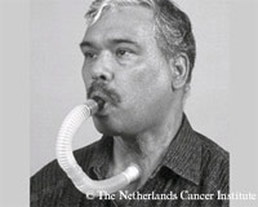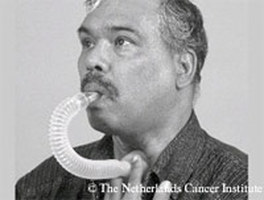Clinical research on postlaryngectomy olfactionDeterioration of the sense of smell seems an inevitable consequence of total laryngectomy [1]. This bothering side effect of the operation is caused by disconnection of the upper and lower airways, which results in breathing through a tracheostoma in the neck, and thereby absence of nasal airflow (see figures; dashed line indicates airflow). Therefore, odor molecules are no longer passively reaching the olfactory epitheliuma, and patients are effectively anosmic, despite the fact that the olfactory system essentially is intact. Over the years, several studies have established this problem, without finding a solution for this 'nuisance'. Most patients actually seem to accept this problem, probably due to proper counseling prior to the surgery and to the lack of an effective rehabilitation method [1, 2]. The absence of complaints about this problem is actually quit surprising in view of the many patients finding their way to the otolaryngology practice in case of a sudden or gradual loss of the sense of smell, which in laryngeal patients apparently is considered to be an unacceptable symptom of what is often suspected to be a sign of a serious underlying illness [3].
|

